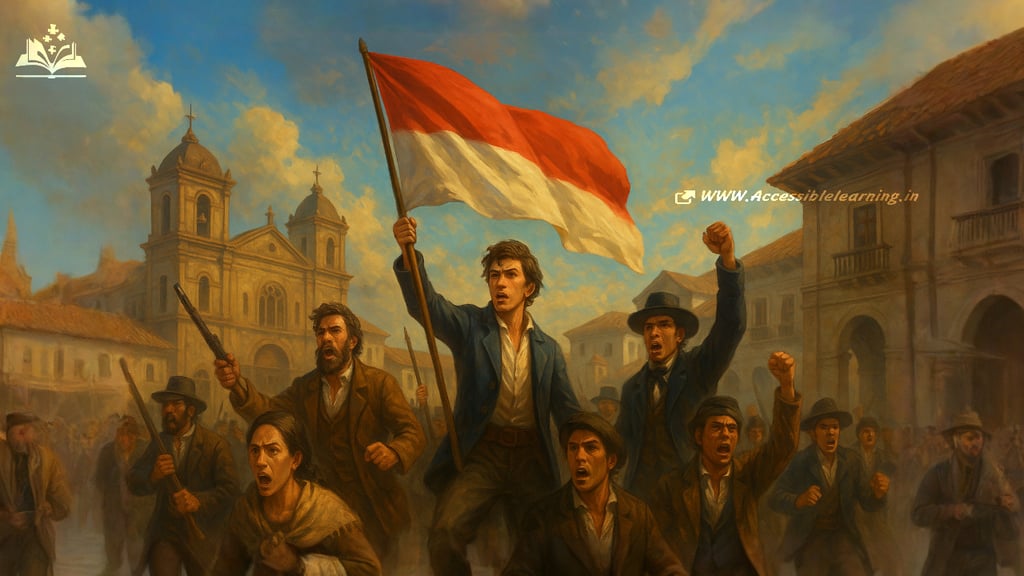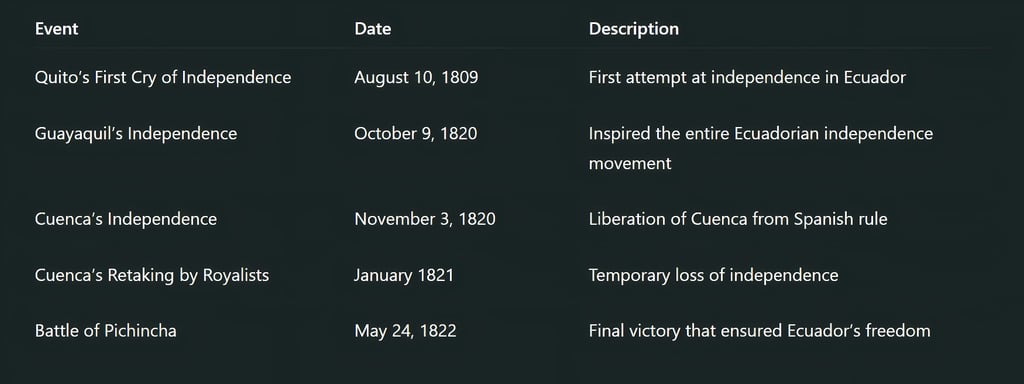
Independence of Cuenca: Ecuador’s Fight for Freedom and Identity
Discover the story of the Independence of Cuenca, Ecuador’s defining moment of courage and unity. Learn how this historic uprising on November 3, 1820, helped shape Ecuador’s freedom, identity, and culture. Explore its heroes, struggles, and lasting legacy that continues to inspire the Ecuadorian spirit today.
EVENT/SPECIALCELEBRATION/FESTIVALSEUROPEAN POLITICS
---
10/24/20257 min read


The Independence of Cuenca, celebrated on November 3rd, marks one of the most significant milestones in Ecuador’s history. This event symbolizes not only the liberation of Cuenca from Spanish rule but also the rise of national consciousness and civic unity that fueled Ecuador’s independence movement.
Located in the southern Andes, Cuenca was a flourishing colonial city under Spanish control. Yet, beneath its beauty and religious devotion, a revolutionary spirit was growing—driven by intellectuals, patriots, and ordinary citizens who longed for self-governance, justice, and equality.
The Historical Context: Latin America’s Revolutionary Wave
By the early 19th century, most of Latin America was awakening to revolutionary ideas. The Napoleonic invasion of Spain in 1808 had weakened the Spanish Empire, creating political uncertainty in its colonies. Across South America, people began to question foreign domination.
In Quito (Ecuador’s capital), the First Cry of Independence occurred on August 10, 1809, marking the beginning of Ecuador’s liberation efforts. Although that uprising was suppressed, it inspired other cities like Guayaquil and Cuenca to take similar action in the following years.
Cuenca, known for its educated elite, artisans, and clergy, became a fertile ground for revolutionary thought. Its citizens began discussing the concepts of liberty, sovereignty, and human rights—ideas that had spread from Europe and North America.
The Road to Independence: Seeds of Rebellion
The people of Cuenca were deeply influenced by the independence movements taking place in Venezuela, Colombia, and Argentina. Communication between revolutionaries in different cities was vital. Patriots in Cuenca organized secret meetings to plan their liberation strategy.
By 1820, Guayaquil had declared its independence, becoming a beacon of hope for neighboring provinces. Inspired by this success, Cuenca’s citizens decided it was time to act. On November 3, 1820, a group of patriots led by Tomás Ordóñez, José María Vázquez de Noboa, and others took control of the city. They overthrew the Spanish authorities, raised the flag of freedom, and proclaimed Cuenca as a free city.
This act of bravery was not isolated—it was part of a chain reaction that ultimately united the territories into what would become the Republic of Ecuador.
Key Figures of Cuenca’s Independence
The independence of Cuenca was not achieved by armies alone. It was the result of courage, vision, and leadership from men and women who risked their lives for freedom.
Tomás Ordóñez: A central leader in the uprising, known for his charisma and determination to free Cuenca.
José María Vázquez de Noboa: An intellectual who contributed to the revolutionary ideology and strategic planning.
Abdón Calderón: Though only a teenager at the time, he later became a national hero for his bravery in the Battle of Pichincha (1822).
Manuela Espejo and the Espejo family: Earlier revolutionaries from Quito who inspired Cuenca’s independence through their writings and activism.
These individuals, along with many unnamed patriots, shaped the destiny of a city yearning for sovereignty.
Aftermath: The Struggle Continues
Although Cuenca declared independence in November 1820, maintaining it was a challenge. Spanish royalist forces soon launched counterattacks to reclaim control. For months, Cuenca faced violent confrontations and political instability.
True freedom arrived in 1822, after the Battle of Pichincha, when General Antonio José de Sucre and his forces defeated the Spanish troops near Quito. This victory secured the independence of all Ecuadorian provinces, including Cuenca, and marked the official liberation of Ecuador from Spanish colonial rule.
Cultural and National Legacy
The Independence of Cuenca is celebrated every year with parades, concerts, and cultural events that highlight the city’s heritage and pride. It is not just a holiday—it is a living reminder of the resilience, unity, and faith that define Cuenca’s people.
Today, Cuenca is recognized as a UNESCO World Heritage Site, admired for its colonial architecture and strong cultural identity. But behind its peaceful beauty lies the memory of struggle, sacrifice, and the unyielding pursuit of freedom.
The ideals of 1820 continue to resonate in Ecuador’s modern democracy—a nation built on courage and independence.
Interesting Facts About Cuenca’s Independence
Cuenca was one of the last major cities in Ecuador to join the independence movement, yet its victory was crucial to national unification.
The flag of Cuenca, featuring red and white, symbolizes the blood of martyrs and purity of purpose.
Cuenca’s independence is celebrated for three consecutive days (November 1–3), blending national pride with traditional cultural festivities like the Day of the Dead and All Saints’ Day.
The city’s colonial core remains almost unchanged since the 19th century, preserving the atmosphere of the era when revolutionaries fought for freedom.
Why Cuenca’s Independence Still Matters Today
The independence movement of Cuenca was more than a political revolt—it was a moral awakening. It reminds us that freedom is not merely granted; it is earned through unity, sacrifice, and a shared vision for justice.
In a world still grappling with inequality and power struggles, Cuenca’s story offers a timeless lesson: that ordinary people, when united by purpose, can redefine their nation’s destiny.
The Independence of Cuenca remains a symbol of Ecuadorian pride and perseverance. It represents a moment when courage triumphed over oppression, and unity replaced division. The people of Cuenca didn’t just liberate a city—they helped lay the foundation for a nation that would stand free and proud.
Every November, as the bells ring across Cuenca’s historic churches and the streets fill with color and celebration, Ecuadorians remember that freedom was not inherited—it was fought for, cherished, and passed down through generations.



FAQs
Q: What country does Cuenca belong to?
Cuenca is located in Ecuador, a beautiful country in the northwestern part of South America. It’s the third-largest city in the nation, after Quito and Guayaquil, and is known for its colonial charm, cultural richness, and historical significance.
Q: When did Ecuador gain full independence?
Ecuador gained full independence on May 24, 1822, after the Battle of Pichincha, where General Antonio José de Sucre and his troops defeated the Spanish royalists near Quito. This victory ensured complete freedom for all Ecuadorian provinces, including Cuenca.
Q: What language do people in Cuenca and Ecuador speak?
The official language of Ecuador is Spanish. However, indigenous languages like Quechua (Kichwa) and Shuar are also spoken in some regions. Cuenca’s people typically speak a soft, clear Spanish dialect known for its polite and melodic tone.
Q: What is Cuenca famous for today?
Cuenca is world-famous for:
Its UNESCO World Heritage historic center
Handcrafted Panama hats (ironically made in Ecuador, not Panama)
Its beautiful churches, plazas, and colonial architecture
A strong tradition of art, music, and festivals
Being a hub for expats and retirees due to its peaceful lifestyle and affordable living
Q: What kind of people live in Cuenca?
Cuenca’s people, known as Cuencanos, are warm, respectful, and family-oriented. They take pride in their city’s history and are deeply rooted in cultural traditions, religion, and education. Many Cuencanos balance modern lifestyles with traditional values, reflecting Ecuador’s broader cultural harmony.
Q: What is Ecuador’s culture like overall?
Ecuador’s culture is a vibrant mix of Indigenous, Spanish, and Afro-Ecuadorian influences. The country is known for:
Colorful festivals like Inti Raymi, Carnaval, and Cuenca’s Independence Day
Traditional music such as pasillo and sanjuanito
Deep spiritual and family values
A strong connection to nature, especially the Andes, Amazon, and Galápagos Islands
Q: What is the meaning behind Ecuador’s name?
“Ecuador” means “Equator” in Spanish. The country is named for its geographical position—it literally straddles the equatorial line, with the equator running right through the country. Visitors can even stand with one foot in each hemisphere near Mitad del Mundo (“Middle of the World”), just north of Quito.
Q: How do Ecuadorians celebrate independence days?
Ecuadorians celebrate independence with music, parades, dances, fireworks, and historical reenactments. Each major city—Quito, Guayaquil, and Cuenca—has its own independence day. Cuenca’s celebrations in early November are among the most vibrant, blending national pride with traditional Andean festivities.
Q: What religion do most Ecuadorians follow?
The majority of Ecuadorians are Roman Catholic, though there are growing communities of Evangelicals and other Christian groups. Religious festivals, saints’ days, and church events remain central to community life, especially in Cuenca.
Q: Is Ecuador a safe and peaceful country?
Ecuador is generally peaceful and friendly, especially in cities like Cuenca. The people are known for their hospitality toward foreigners. While big cities face some urban challenges, Cuenca stands out as one of the safest and most livable places in South America.
Fascinating Facts About Ecuador and Cuenca
> Ecuador is one of the world’s most biodiverse countries
Despite its small size, Ecuador is home to the Amazon rainforest, the Andes mountains, the Pacific coast, and the Galápagos Islands—all within a few hours’ travel. It’s one of the few places where you can see snow-capped volcanoes and tropical beaches in the same day.
> Cuenca’s Independence is part of Ecuador’s “Triad of Freedom.”
Ecuador celebrates three main independence milestones:
Quito (1809)—The first cry of freedom
Guayaquil (1820)—The start of the revolution
Cuenca (1820)—The consolidation of national unity
Together, these movements built the foundation of the modern Ecuadorian Republic.
> Panama hats come from Cuenca
The world-famous “Panama Hat” actually originates in Cuenca, Ecuador, not Panama. The misnomer began when the hats were shipped through Panama during the 19th century. Each hat can take weeks to hand-weave, symbolizing Cuenca’s artistry and patience.
> Cuenca’s architecture tells its story
Cuenca’s historic center is a masterpiece of Spanish colonial design—cobblestone streets, terracotta roofs, and grand cathedrals like the New Cathedral (Catedral de la Inmaculada Concepción). This preservation earned Cuenca its UNESCO World Heritage status in 1999.
> Ecuador uses the U.S. dollar
Since 2000, Ecuador has used the U.S. dollar as its official currency. This makes it easier for tourists and foreign investors, though it also reflects Ecuador’s unique economic history and modernization efforts.
> Ecuador is home to the world’s closest point to the sun
Because of its location at the equator and the elevation of Mount Chimborazo, the mountain’s peak is the closest point on Earth to the sun, even higher than Everest when measured from the planet’s core.
> Cuenca is called “The Athens of Ecuador.”
Cuenca earned this nickname for its deep intellectual and artistic legacy. Many of Ecuador’s most respected writers, painters, poets, and philosophers came from Cuenca. The city’s calm rhythm fosters creativity and thought.
> Ecuadorians value family above all
Family is central to Ecuadorian culture. Extended families often live close together, and gatherings are frequent. Respect for elders, hospitality, and community solidarity are key social values, especially in Cuenca.
> Ecuadorian cuisine reflects its geography
From Andean grains and potatoes to seafood ceviche and Amazonian yucca dishes, Ecuador’s cuisine blends indigenous and Spanish influences. In Cuenca, traditional dishes like mote sucio, hornado, and locro de papas are everyday favorites.
> Cuenca’s people are known for humility and pride
Cuencanos are admired for being polite, humble, and hardworking, yet deeply proud of their history. Their quiet dignity reflects the same strength that fueled their ancestors’ independence movement.
Subscribe to our newsletter
All © Copyright reserved by Accessible-Learning
| Terms & Conditions
Knowledge is power. Learn with Us. 📚


